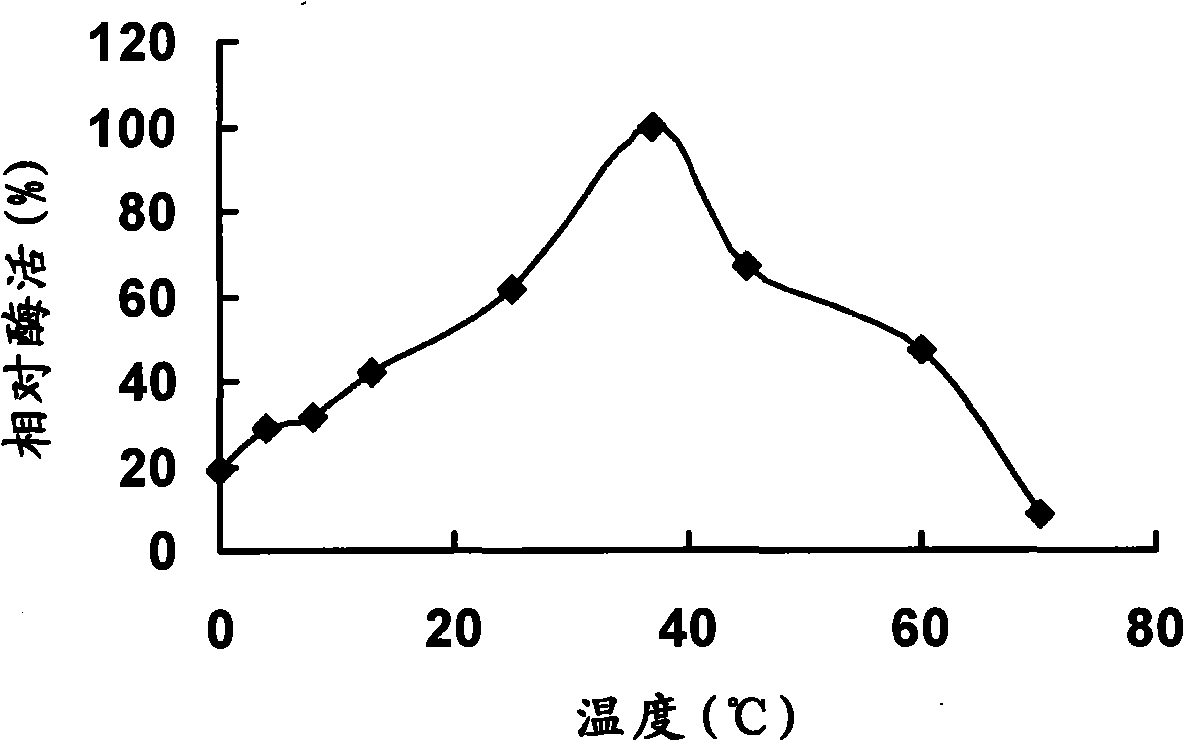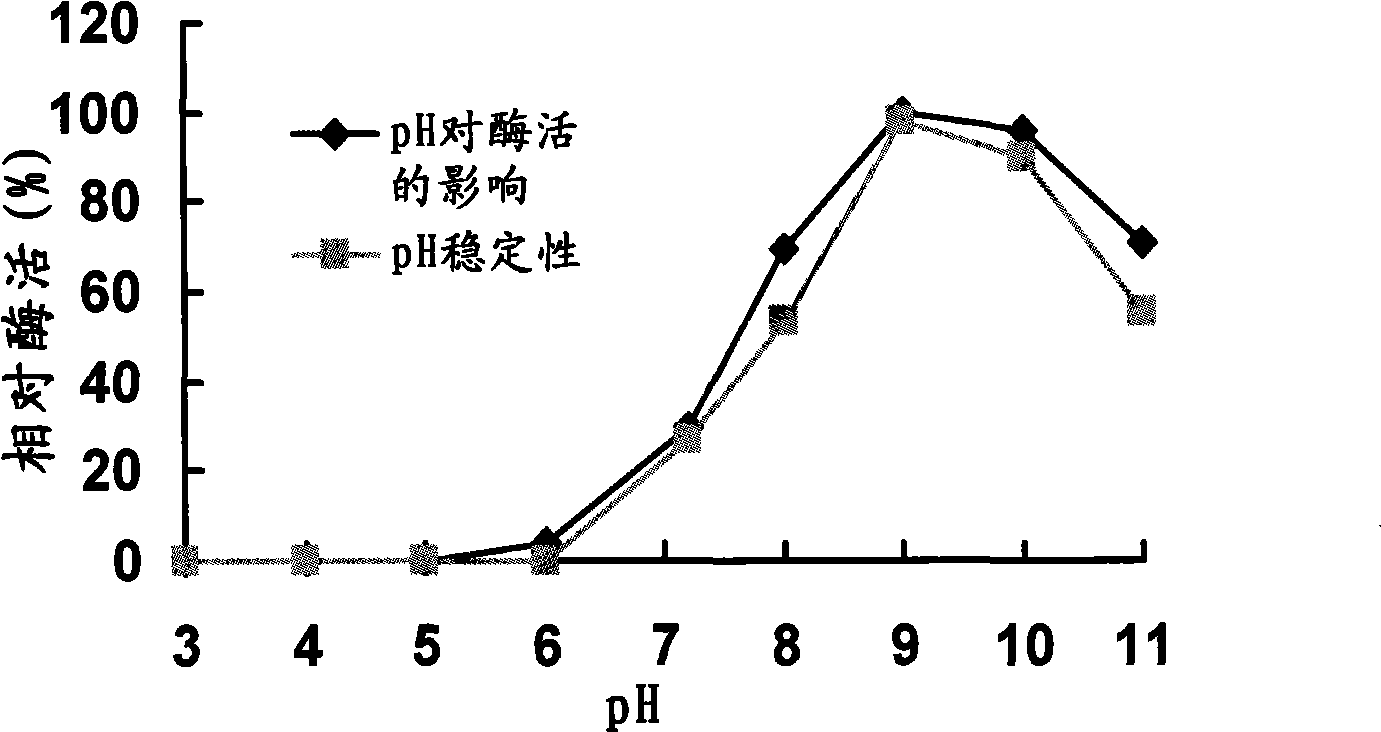Yersinia strain KM1, low temperature alkaline lipase prepared thereby and purification method thereof
A technique for Yersinia, purification methods, applied in microorganism-based methods, biochemical equipment and methods, bacteria, etc.
- Summary
- Abstract
- Description
- Claims
- Application Information
AI Technical Summary
Problems solved by technology
Method used
Image
Examples
Embodiment 1
[0033] Isolation, screening and identification of Yersinia enterocolitica KM1 strain:
[0034] Yersinia enterocolitica (Yersinia enterocolitica) KM1 strain was isolated from the cold storage of Kunming East Railway Station slaughterhouse. Strain selection medium is (g / L): tryptone, 10; yeast extract, 5; NaCl, 10; olive oil emulsion, 2%; agar, 20; pH7.0-7.2.
[0035] Yersinia sp. KM1 strain was identified by bacterial system identification method. The morphological characteristics of the bacteria are as follows: the colonies are round, with neat edges, moist, milky white, sticky, easy to pick; the cells are short rod-shaped, Gram-negative bacteria. The pH range for enzyme production is 4.0-9.5, the optimum pH is 7.2; the temperature range for enzyme production is 4-37°C, the optimum temperature for enzyme production is 13°C; the time range for enzyme production is 18-66 hours, the optimum enzyme production The time is 54 hours. The physiological and biochemical characteristi...
Embodiment 2
[0039] Purification of cryogenic lipase
[0040] (1) Preparation of crude enzyme solution: the fermentation and culture conditions of Yersinia sp. KM1 strain were temperature 13° C., pH 7.2, and culture time 52 hours. The fermentation broth is centrifuged, and the supernatant is obtained as the crude enzyme solution.
[0041] (2) Ammonium sulfate precipitation: Add ammonium sulfate to the crude enzyme solution to 30-40% saturation, centrifuge to take the supernatant, continue to add ammonium sulfate to 70-80% saturation, centrifuge to discard the supernatant, precipitate at 25mM, pH7.0 -8.0 phosphate buffered saline overnight.
[0042] (3)Sephacry TM HRS-100 chromatography: Centrifuge the dialyzed enzyme solution, concentrate the supernatant, and load the Sephacry pre-equilibrated with 25mM, pH 7.0-8.0 phosphate buffer TMHRS-100 chromatographic column, the flow rate is 0.4ml / min, elution, the enzyme active part is collected, and the concentrated solution is collected by ce...
Embodiment 3
[0048] Characteristics of low temperature lipase:
[0049] ①Optimum enzyme activity temperature
[0050] Add the enzyme liquid to phosphate buffer (25mM phosphate buffer, pH7.2), use pNPB as substrate, and measure the enzyme activity of lipase produced by KM1 strain at different temperatures in the range of 0-70°C. The result is as figure 1 As shown, it shows that the optimum enzyme activity temperature of the low-temperature lipase is 37°C, and there is still nearly 20% activity at 0°C. When the temperature exceeds 40°C, the enzyme activity drops sharply, and the residual enzyme activity is less than 10% when the temperature reaches 70°C. %, this result shows that the lipase has the typical characteristics of low-temperature enzymes, that is, the reaction temperature of the enzyme is low.
[0051] ②Thermal stability
[0052] Add the enzyme solution to phosphate buffer (25mM phosphate buffer, pH 7.2), keep it warm in constant temperature water baths at different temperature...
PUM
| Property | Measurement | Unit |
|---|---|---|
| Molecular weight | aaaaa | aaaaa |
Abstract
Description
Claims
Application Information
 Login to View More
Login to View More - R&D
- Intellectual Property
- Life Sciences
- Materials
- Tech Scout
- Unparalleled Data Quality
- Higher Quality Content
- 60% Fewer Hallucinations
Browse by: Latest US Patents, China's latest patents, Technical Efficacy Thesaurus, Application Domain, Technology Topic, Popular Technical Reports.
© 2025 PatSnap. All rights reserved.Legal|Privacy policy|Modern Slavery Act Transparency Statement|Sitemap|About US| Contact US: help@patsnap.com



